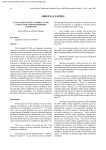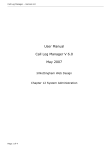Download risk of occlusion due to faulty valve [65KB PDF
Transcript
HAZARD NOTICE By arrangement with the Scottish Government Health Directorates GALEMED CORP / SMITHS MEDICAL EMS VENTILATOR CIRCUITS: RISK OF OCCLUSION DUE TO FAULTY VALVE HAZ(SC)07/23 21 NOV 2007 Medical Devices Page 1 of 4 Pages SUMMARY Certain Galemed Corp / Smith Medical EMS ventilator circuits may contain a faulty valve which can occlude the circuit. Implicated Lots should be removed from use immediately. BACKGROUND 1. EMS ventilator circuits, product code W196-002, are manufactured by Galemed Corporation and supplied by Smiths Medical. They are breathing systems for use with Smiths Medical emergency and transport ventilators including: Parapac, Ventipac, Rescupac and Transpac models which are used in emergency situations and during the transport of adults, children and infants. 2. A manufacturing problem has been identified where the valve in these breathing systems will not open, resulting in a blockage and potentially no oxygen being delivered to the patient. Galemed Corporation believes that this issue only affects the three Lot numbers of EMS ventilator circuits: 070528, 070620, 070910. 3. Galemed Corporation has made changes to its manufacturing method and quality assurance checks to try and prevent this issue from recurring. They have issued a product withdrawal notice and confirmed that replacement stocks manufactured using the improved techniques will be available. ACTION 4. This notice should be brought to the attention of all appropriate managers, staff and users. 5. Implicated Lots of EMS ventilator circuits should be identified, removed from use and placed in quarantine. 6. Smiths Medical should be contacted (see Enquiries) to arrange disposal and replacement of the implicated devices. 7. If replacement EMS ventilator circuits are not available then alternative ventilators and their breathing systems should be made available. Failing this: a) hospitals should ensure that pre-use checks are undertaken for all EMS ventilator circuits (see excerpt from Smith Medical’s ventilator user manual in the Appendix), b) ambulance services should check the ambulance stock immediately and further stock should be checked before being placed on the vehicle (see Appendix). Suggested Distribution Coronary Care Units Medical Operating Departments Special Care Baby Units Accident & Emergency Day Surgery Medical Physics Paediatrics Stores Ambulance Services Health & Safety Neonatal Resuscitation Teams Supplies/Procurement Anaesthetics Intensive Therapy Units Nursing Risk Management SCOTTISH HEALTHCARE SUPPLIES Gyle Square Edinburgh EH12 9EB A Division of the National Service Scotland for NHSScotland CONTACT EMAIL: [email protected] WEBSITE: http://www.nhsscotland.com/shs/hazards_safety/adverse_p.html FAX: 0131 314 0722 N:\WORD\HAZ\IRIC PUBLICATIONS\FINAL HAZ\PUBLIC HAZ\PHAZ0723.DOC HAZARD NOTICE By arrangement with the Scottish Government Health Directorates GALEMED CORP / SMITHS MEDICAL EMS VENTILATOR CIRCUITS: RISK OF OCCLUSION DUE TO FAULTY VALVE HAZ(SC)07/23 21 NOV 2007 Medical Devices Page 2 of 4 Pages 8. An alternative oxygen supply and means of ventilation should always be available when using any ventilator e.g. a self-inflating bag and oxygen cylinder. 9. Adverse incidents involving EMS ventilator circuits should be reported to Scottish Healthcare Supplies. ENQUIRIES Enquiries to the manufacturer should be addressed to: Bob Roe, Sophie Matthews or Lorraine Evans Smiths Medical Bramingham Business Park Enterprise Way Luton LU3 4BU Tel: 01923 241 411 Fax: 01923 256 790 SCOTTISH HEALTHCARE SUPPLIES Gyle Square Edinburgh EH12 9EB A Division of the National Service Scotland for NHSScotland CONTACT EMAIL: [email protected] WEBSITE: http://www.nhsscotland.com/shs/hazards_safety/adverse_p.html FAX: 0131 314 0722 N:\WORD\HAZ\IRIC PUBLICATIONS\FINAL HAZ\PUBLIC HAZ\PHAZ0723.DOC HAZARD NOTICE By arrangement with the Scottish Government Health Directorates GALEMED CORP / SMITHS MEDICAL EMS VENTILATOR CIRCUITS: RISK OF OCCLUSION DUE TO FAULTY VALVE HAZ(SC)07/23 21 NOV 2007 Medical Devices Page 3 of 4 Pages APPENDIX WARNING: To avoid harm to the patient, pre-use checks must be performed before each use. (b) Functional Check The following procedure should be followed when first setting up the ventilator to check that it has been assembled correctly and is operating safely. It should be repeated periodically as specified under 'Maintenance'. 1. Check the ventilator controls as follows:Main Pneumatic Switch: Frequency Tidal Volume: Air Mix Switch Relief Pressure: 'Demand' (Model 200D) '0' (Model 200) 12 b/min (detent position) 900ml 'No Air Mix' 40 x100Pa (40 cmH2O) 2. Connect the probe on the input hose to an appropriate gas outlet. 3. If connected to a cylinder regulator turn on cylinder valve slowly. NOTE: The gas source must be capable of maintaining a pressure of at least 305 kPa (≈ 3 bar) whilst delivering a flow of 65 l/min. 4. Check that the visual alarm for supply gas failure has changed from red to white. 5. Switch the main pneumatic switch to '1' (Model 200) or ‘CMV/Demand’ (On) (Model 200D). The ventilator should commence cycling and all the alarm lights flash in turn. A single burst of the high priority audible alarm is given at the same time. The orange silencing indicator should flash for 60 seconds. Check that the flow is coming from the patient connection port by feeling the flow when placed close to the back of the hand or to the face. 6. Occlude the output port on the patient valve and check that the manometer gives a reading of between 30 and 50 cmH2O during each inspiratory phase. The pneumatic audible alarm should also sound, accompanied by the high inflation pressure visual alarm. After occlusion for one second, once the silencing period has elapsed, the high priority electronic audible alarm will also sound. Check that the unit cycles regularly about every 5 seconds. 7. Switch over to 'Air Mix' and repeat step 6. The change in the manometer reading should not exceed 5 x100Pa (5 cmH2O). NOTE: After the 60 second initial silenced period the electronic audible alarms will operate if an alarm condition persists. These can be silenced for as long as required by depressing the silencing button each time the silencing indicator switches off. SCOTTISH HEALTHCARE SUPPLIES Gyle Square Edinburgh EH12 9EB A Division of the National Service Scotland for NHSScotland CONTACT EMAIL: [email protected] WEBSITE: http://www.nhsscotland.com/shs/hazards_safety/adverse_p.html FAX: 0131 314 0722 N:\WORD\HAZ\IRIC PUBLICATIONS\FINAL HAZ\PUBLIC HAZ\PHAZ0723.DOC HAZARD NOTICE By arrangement with the Scottish Government Health Directorates GALEMED CORP / SMITHS MEDICAL EMS VENTILATOR CIRCUITS: RISK OF OCCLUSION DUE TO FAULTY VALVE HAZ(SC)07/23 21 NOV 2007 Medical Devices Page 4 of 4 Pages 8. Set the 'Tidal Volume' control to its minimum setting. Occlude the output port and check that at least 20 x100Pa pressure is attained on the manometer. Gradually increase the flow setting and observe how the pressure rises - demonstrating the pressure generator principle. At the end of the green segment the pressure should be attaining the nominal set value. 9. Reset the 'Tidal Volume' control to its minimum setting and select 'No Air Mix'. Occlusion of the output port should now cause the manometer to rise sharply to between 30 and 50 x100Pa and the alarms should operate. 10. Allow the ventilator to cycle with no obstruction at the output port and check that the low inflation pressure (disconnect) alarm operates after 10 seconds. 11. Set the 'Frequency' and 'Tidal Volume' control knobs to the extremes of their range. By listening to the gas flow, check that the ventilator is responding to the controls and that no irregularities of performance can be discerned. 12. If the ventilator is likely to be used with very small babies the following additional test should be carried our during the periodic test and after reassembly of the patient valve every time it is dismantled:Connect the ventilator to a gas source and set the 'Tidal Volume' control to minimum and the air mix switch to 'Air Mix'. Attach a flexible reservoir bag (preferably 1/2 litre) to the patient connector of the patient valve and switch on the main pneumatic switch. Roll up the end of the reservoir bag to decrease its effective volume until the end inspiration inflation pressure rises to about 10 x100Pa. Check that this pressure can be attained consistently every breath. If it cannot, dismantle the patient valve, turn the valve element (rubber disc) about a quarter of a turn and reassemble and retest. If after two or three adjustments consistent performance cannot be achieved the valve element must be replaced. 13. Finally, set the controls as specified in step 1 so that the ventilator is left set for emergency use. WARNING: Deviations noted at functional check should be reported immediately to Pneupac and the unit must be taken out of service to avoid the risk of death or serious injury. WARNING: Avoid smoking or naked flame. To avoid the risk of ignition, do not use oil, grease or combustible lubricants (only those approved for oxygen use) in contact with any part of the ventilator, regulator or cylinder. WARNING: To avoid ignition by adiabatic compression, connect the ventilator to the regulator before opening the cylinder valve slowly. Similarly, prior to changing cylinders, turn off the cylinder valve, switching on the ventilator. When the ventilator stops, it is safe to release the pin index yoke. PRECAUTION: It is recommended that the valve on the gas cylinder is turned off after use to ensure that the cylinder contents are not lost during storage due to small leakages. SCOTTISH HEALTHCARE SUPPLIES Gyle Square Edinburgh EH12 9EB A Division of the National Service Scotland for NHSScotland CONTACT EMAIL: [email protected] WEBSITE: http://www.nhsscotland.com/shs/hazards_safety/adverse_p.html FAX: 0131 314 0722 N:\WORD\HAZ\IRIC PUBLICATIONS\FINAL HAZ\PUBLIC HAZ\PHAZ0723.DOC




![potential power supply failure [PDF 123KB]](http://vs1.manualzilla.com/store/data/006020611_1-7b2a515ae5adf40e5465ac14994129f2-150x150.png)
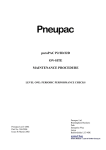
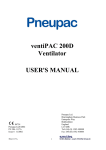
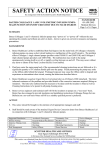
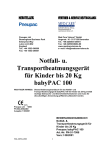
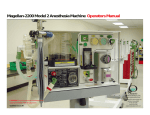
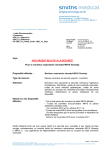
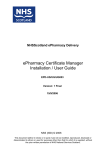

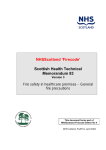
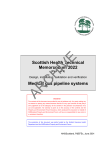
![General design guidance [PDF 950KB]](http://vs1.manualzilla.com/store/data/005804077_1-5fec14441b6361d04901f77e13b8a9c0-150x150.png)
